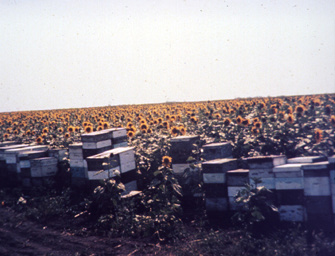
Bee Basics
Bees may not have a good reputation because of their ability to sting, but many are important and beneficial. Honey bees are the bees with the best public image. We see them as industrious ("busy as a bee") and we appreciate their main product, honey, as setting the standard for all that is wonderful and sweet. Here we will discuss some basic facts and history about bees.
Over 25,000 species of bees have been identified in the world, with perhaps as many as 40,000 species yet to be identified. In the continental United States scientists have found approximately 3,500 species of bees. The desert regions of northern Mexico and southern Arizona have the richest diversity of bees found anywhere in the world. Although there is no exact count, a bee scientist at the USDA Carl Hayden Bee Research Center says there are between 1,000 and 1,200 species of bees within 100 miles of Tucson!
You may wonder how this can be true. It turns out that not all bees are social bees that live in large families like bumble bees and honey bees. Most are less well-known bees called solitary bees, for example carpenter bees, leafcutter bees, alkali bees, digger bees or sweat bees. Female solitary bees build their own nests and provide food for only their own offspring. All bees collect pollen and nectar, and many of the solitary species are essential because they pollinate plants ignored by honey bees.
What we call honey bees are represented by eight to 10 species in the genus Apis, a name from which comes the word for beekeeping (apiculture) and the word for a bee yard (apiary). The species of honey bee commonly found today in Europe, Africa, the Middle East and the Americas is Apis mellifera, which means honey carrier. This name is not technically correct as the bees carry nectar from flowers which they then use to produce honey back in the hive. Only when the bees are moving to a new nest (swarming) do they carry honey.
There are 24 races of Apis mellifera. The races have different physical and behavioral characteristics such as body color, wing length, and susceptibility to disease. But, since they are all of the same species, bees from one race can mate with bees from another race, creating even more variation within the honey bee universe. Caucasian bees ( A. mellifera caucasica) are known to be extremely docile, whereas the black or German bees ( A. mellifera mellifera) are known to overwinter well in severe climates. The African group of bees includes not only the largest number of geographic races (12), but also some of the best known, such as the notorious A. mellifera scutellata. It was a few queens of this highly defensive race that were brought into Brazil in 1957 and started the bees we now know as "Africanized honey bees."
The true honey bee was not native to the Americas. Prior to Columbus, people in Central and South America collected honey from bees known as "stingless bees." Although stingless bees do actually lack a stinger, they are not completely defenseless. They can inflict painful bites with their mandibles. They also do not produce honey in the same quantity as A. mellifera.
In the early part of the 16th century, the Spanish brought over the first honey bee colonies. English colonists did the same and soon honey bees had escaped into the wild and were buzzing all over North America. In some cases, the honey bees travelled in advance of the European settlers and came in contact with Native American tribes, who dubbed them "white man's flies." By the time the frontier had been settled, late in the 19th century, honey bees were regarded as a natural part of the insect world in North America.
In Brazil and other tropical areas, the introduced honey bees did not survive as well as they did in temperate climates. In an effort to improve honey production in the tropics, a scientist began some breeding experiments using some of the common European honey bees and crossing them with the A. mellifera scutellata bees. This Africanized mixture proved to have the highly defensive behavior of the African race. In 1957 some of the bees escaped, and they have been slowly spreading northwards ever since. Africanized honey bees reached Arizona in 1993.
More than 211,000 beekeepers maintain about 3.2 million honey bee colonies in the United States. Beekeepers often use their bees for pollination of crops rather than for honey production. In fact, one third of our food production is the direct result of pollination by insects. So, although we will have to be more cautious of honey bees in the future, they will remain an important part of our environment.
